
Our October 2010 hostess, Lori of Lori’s Lipsmacking Goodness, has challenged The Daring Cooks to stuff grape leaves. Lori chose a recipe from Aromas of Aleppo and a recipe from The New Book of Middle Eastern Food.
Stuffed grape leaves, with meat or without, they are delicious on their own or on some pita bread as a sandwich. You can eat them simply, drizzle with olive oil and lemon juice and sprinkle on some feta and you have a delicious appetizer, serve with tomato, cucumber wedges and kalamata olives.
Recipe Source: Two recipes for October.
One of the recipes comes from Aromas of Aleppo written by Poopa Dweck and Michael J. Cohen. The other is from Claudia Roden's, The New Book of Middle Eastern Food.
[I opted to make the one with meat.]
Historical Note: Stuffed grape leaves are a part of many cultures including the Syrians, the Turks, the Greeks, the Lebanese, the Albanians, the Israeli's, the Iranians, the Iraqis and the Armenians (just to name a few). Generally speaking the stuffed part could be in zucchinis/courgette, eggplant, tomato or peppers. Really it also extends to stuffing certain types of fish as well. It is suggested that the origin of stuffed grape leaves goes back to the time when Alexander the Great besieged Thebes. It has also been suggested the Byzantines refined and spiced up the recipe and used the leaves of other vines such as hazelnuts and figs.
Mandatory: The challenge this month is to make a filling and roll it in grape leaves. If grape leaves are unavailable to you then you can use Swiss chard, kale, cabbage or some tough green.
Variations allowed: Grape leaves can usually be found in jars at Mediterranean stores or grocery stores that have ethnic foods. Do stick with a tougher green if you cannot find grape leaves. Spinach, a delicate green, will not hold up to the boiling process. I highly encourage you to use grape leaves if you can.
[Finding brined grape leaves was harder than I thought. I ended up using mostly cabbage leaves. I did plant grapes a few years back, but wasn't sure if the leaves were too mature for stuffing.]
Grape Leaves Stuffed with Ground Meat and Rice with Apricot Tamarind Sauce/ Yebra
Adapted from Aromas of Aleppo by Poopa Dweck and Michael J. Cohen. Published by Harper Collins, 2007
Yield: 6 to 8 servings
Ingredients for hashu/filling:
1 pound (455 gm) ground (minced) beef
1/3 cup (80 ml) (2 1/3 oz) (65 gm) short grain rice
1 teaspoon (5 ml) (6 gm) all spice
2 tablespoons (30 ml) vegetable oil
1 teaspoon (5 ml) (6 gm) cinnamon
1 teaspoon (5 ml) (3 gm) kosher (coarse) salt **if using regular table salt only use ½ tsp.**
¼ teaspoon (1¼ ml) (1½ gm) white pepper
1 onion, chopped **optional**
1 cup (5½ oz) (150 gm) pine nuts **optional**
Directions:
1.Soak rice in water, enough to cover, for 30 minutes. Combine meat, rice, allspice, vegetable oil, cinnamon, salt, white pepper, and if desired, onion and pine nuts, in a large mixing bowl. Mix well.
[Straightforward list of ingredients. I found mixing the spices with the non-meat ingredients make for a uniform distribution in the meat. Also, with ground meats I try to mix and compact as little as possible. I don't want hockey pucks... lol :-) ]
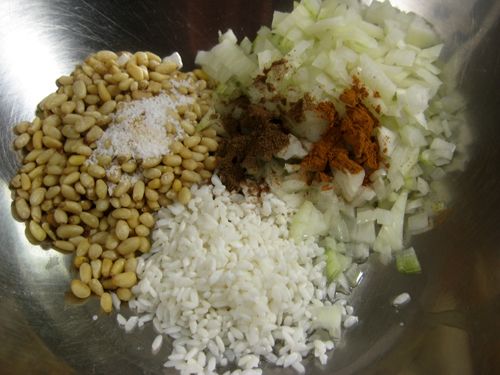
Ingredients for assembly:
1 pound (455 gm) hashu/filling (see recipe above)
36 preserved grape leaves, stems trimmed, drained, rinsed and patted dry
1 tablespoon (15 ml) vegetable oil
6 dried apricots – or more if you desire
3 tablespoons (45 ml) tamarind concentrate **if you can’t find it, you can omit it**
¼ cup (60 ml) freshly squeezed lemon juice
1 tablespoon (15 ml) (9 gm) kosher (coarse) salt **if using regular table salt only use 1.5 tsp.**
Notes:
Tamarind is actually fairly easy to find. There is a paste that is in package already made up. You can find it at Asian, Mexican or Indian grocers. You can also find the pods (a little more difficult) and make it yourself. It is akin to a sweet/tangy tea flavor. If you can’t find it, you can skip the sauce all together. The grape leaves will be just as delicious without the sauce. But we hope that those that can find it will use it.
[Interesting tamarind is called out for this recipe. I didn't know tamarind made it out into Middle Eastern/Greek cuisine.
I bought some tamarind to use for another purpose, which I haven't gotten to... so I used some for this dish.]
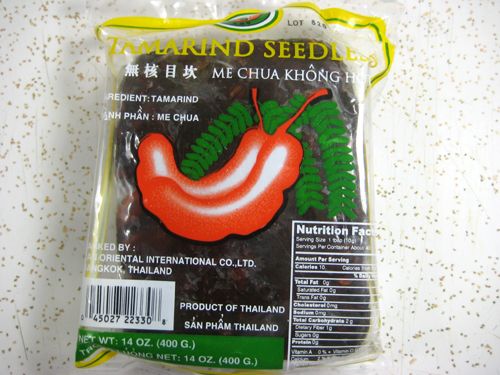
[What I did was soak 1/4 C tamarind in 1 C of boiling water. I used the 1T to 1/4 C water ratio.
I let soak for about 15 minutes and pressed the entire contents through a sieve. The strained mash is what was used for this dish.]

Directions:
1.Place a grape leaf on a flat surface, vein side up. You can trim the little stem if you would like.
[My grape plant... The plant was found on the clearance aisle at the local garden center. It's been 3 years and it's still alive. :-) One of the reasons I planted a grape was to use the grape leaves. This is my opportunity. lol... It's to cold in my area to expect grapes.
I only picked a few of the youngest looking leaves, a little larger than my hand. It's a little late in the season to use grape leaves, but we'll see if it works.]

[Washed and ready for a 1 minute plunge into boiling water.]

2.Place about two teaspoons (10 ml) of the filling in the center of the leaf, near the stem edge.
[In the mean time, I used cabbage leaves.]

3.Roll the leaf end to end, starting from the stem edge. As you roll, fold the sides of the leaf in toward the center. The leaf should resemble a small cigar, about 2 to 2 1/2 inches (50 mm to 65mm) long.
[Start about 1/3rd from and end to place the meat. The rest is like wrapping a burrito.]
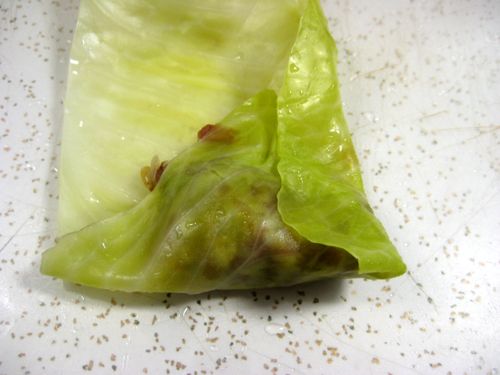
[Rolling the grape leaves... The seem tender enough.]

4.Repeat with the remaining leaves and filling.
a.(You can freeze the stuffed grape leaves at this point. Just line a baking sheet with wax paper. When firmly frozen, transfer to an airtight plastic bag place back in the freezer.)
5.In a medium saucepan put in the vegetable oil and then place the filled grape leaves in the pot.
6.Place apricots in between the stuffed grape leaves. Cover and cook over low heat for 5- 8 minutes or until the grape leaves begin to sweat.
7.Using all three tablespoons, place a little of the tamarind concentrate, if using, over the rolls.
8.Combine lemon juice, salt, and water then add to pan, filling it ¾ full.
[The tamarind mixture poured over the cabbage rolls and dried apricots.]
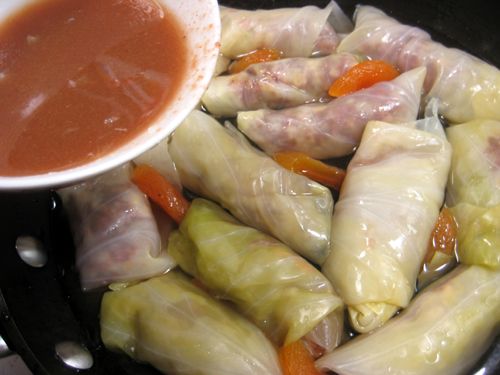
9.Weigh down the grape leaves with a heat proof plate or board to prevent them from unraveling. Cover and bring to a boil over medium high heat. Reduce the heat to low and simmer for about 40 minutes.
[Weighed down for a 40 minute simmer.]
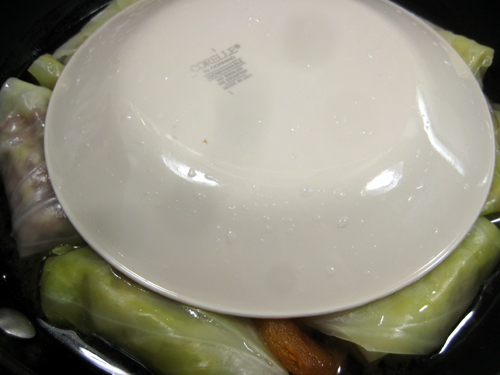
a.Alternatively, place the saucepan in an oven preheated to moderate 350°F/180°C/gas mark 4 and cook for an hour.
10.Spoon cooking liquid over the grape leaves occasionally. You will know they are done, when the grape leaves are neither soupy nor dry.
11.Tilt pan sideways over serving platter, allowing the grape leaves to tumble out. Try not to handle them individually to reduce unraveling.
a.Alternately you can try spooning them out very gently.
The finished goods!
[The rolls maintained their shape. A good sign. :-)]

[Flavor is not bad. I wasn't sure if I would dig the cinnamon, allspice and ground beef combination. It wasn't too bad and not overpowering.
The cooked pinenuts had an interesting (in a good way) texture, almost like a cooked soy beans/edamame - firm but tender.]

